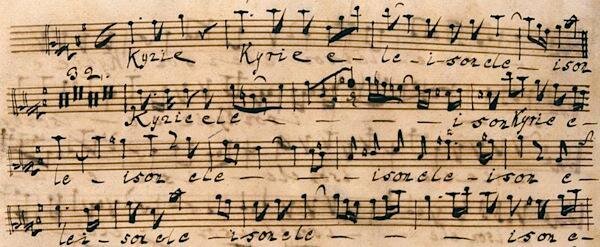Bach’s Mass in B Minor
“The greatest work of music of all ages and of all peoples.”
For our fifth anniversary celebration I had planned to end the festival with a performance of what has become perhaps Bach’s most iconic and famous work, the great Mass in B minor. While we plan to perform that work as soon as we are able, I hope this blog post will whet your appetite and give you some insights into this glorious work.
What prompted Bach to write this extraordinary work? Certainly a mass on this scale would not have found a place in the regular services in Leipzig, and it’s unusual length would seem to discourage a liturgical use for the work, even at the Catholic (and wealthy!) court at Dresden. One is tempted to wonder if he planned a work on this scale even in 1733 when he composed the Kyrie and Gloria sections in B minor. When compared to the four other Kyrie-Gloria Masses composed over a period of several years, the B minor Kyrie-Gloria is more than half again as long as even the longest of the other compositions.
What we do know, however, is that Bach seems to have been occupied in the last years of his life with contrapuntal compositions on a monumental scale. A group of works composed during the last decade of his life (the Goldberg Variations, the Musical Offering, the Canonic Variations on Von Himmelhoch, and, most notably, the Art of Fugue) explored instrumental counterpoint with a methodic thoroughness. And by taking the Kyrie-Gloria Mass in B minor from 1733 and completing the musical setting of the Ordinary of the Catholic mass, he achieved a similar testament to the exploration of vocal counterpoint.
The four shorter Kyrie-Gloria masses (two of which were performed at the fourth Toronto Bach Festival in 2019) were written after the composition of the B minor Kyrie-Gloria of 1733. Bach assembled these shorter masses by adapting and revising movements from the cantata cycles that he wrote in the 1720s. In a similar manner, when he took up the project of expanding the Kyrie-Gloria mass in B minor from 1733, he continued this process of selecting compositions from throughout his career, clearly choosing works of which he was particularly proud. To expand the exploration of vocal counterpoint, he added some newly composed movements to those he had selected from earlier works.What we do know, however, is that Bach seems to have been occupied in the last years of his life with contrapuntal compositions on a monumental scale. A group of works composed during the last decade of his life (theGoldberg Variations, the Musical Offering, the Canonic Variations on Von Himmelhoch, and, most notably, theArt of Fugue) explored instrumental counterpoint with a methodic thoroughness. And by taking the Kyrie-Gloria Mass in B minor from 1733 and completing the musical setting of the Ordinary of the Catholic mass, he achieved a similar testament to the exploration of vocal counterpoint.
Thus, works composed in Weimar three decades earlier found themselves next to new compositions that represented the most sophisticated expressions of contrapuntal art. In this manner he assembled a powerful summation of his compositional art.
This blog is the final one to explore the fifth Toronto Bach Festival, but there will be other announcements, blog posts, and playlists coming over the next months. In fact, we are working hard on our plans for 2020–21 and will be making announcements in the next month or so. In the meantime please enjoy more about the Mass in B minor from Rick Phillips.
Until the next time,
John Abberger
Artistic Director
PLAYLISTS
Mass in B minor
This performance by the Netherlands Bach Society uses 10 voices, just as we were planning, and as we will present it to you in the future.
What is H.I.P?
Watch John Abberger's interview with Rick Phillips.
Bach's Mass in B minor
By Rick Phillips www.soundadvice1.com
On the surface, it’s difficult to understand why J. S. Bach composed his great Mass in B minor. Bach was a Lutheran and spent decades composing music for use in Lutheran church services in Germany, so the composition of a mass—the central service of the Roman Catholic Church—would not have been required of him. Nevertheless, Bach did write a total of five masses.
In the Roman Catholic mass there are five main sections—Kyrie, Gloria, Credo, Sanctus (including a Benedictus) and Agnus Dei. In the Lutheran Church of Bach’s day, it was an accepted practice to employ just the opening two movements of the Catholic mass. Consequently, there are four short “Lutheran” masses by Bach, containing just the Kyrie and Gloria sections. These Lutheran masses, in G Major, G minor, A Major and F Major by Bach were all composed for this Lutheran church service use. But what about the B-minor Mass, a full-scale, high Catholic mass, where the Kyrie and Gloria alone take up an hour? This is a work for choir and orchestra, so huge in scope and scale that it would never have found a place in church—Lutheran or Roman Catholic. So why would Bach bother to compose it? The answer may be found in Bach’s own conception and approach to music.
To Bach, music was much more than just a vocation. To him, it was also a fascination, a hobby, a love and a way of life. Throughout his life, he studied and absorbed music by earlier and contemporary composers. This knowledge and love then acted as an inspiration to him, so that when he composed, he assimilated this knowledge into his own music.
Many great composers before Bach had composed masses, and it’s not surprising that Bach himself wanted to try his hand at it, to make his own contribution to the great legacy and tradition of the musical mass. The Mass in B minor is a wonderful mixture of many musical styles and techniques. It was both new and old, with traits of the Baroque period styles as well as the Renaissance and earlier. German, French, Flemish and Italian influences are all evident, as is the then-current style of the operatic da capo aria.
Bach created the Mass in B minor in a piecemeal fashion over a period of about twenty-five years, between 1724 and 1749. Much of it was culled from previous music he had composed and re-worked. And yet it is unbelievable how concise and well-designed the work is. It’s incredibly unified, as if he wrote the mass in one sitting.
As in many of his sacred works, like the cantatas, passions and Christmas Oratorio, Bach included symbolism in the music—musical symbols and metaphors that strengthen the meaning of the message and the feelings and emotions they create. For example, in the section dealing with Christ’s crucifixion in the Credo, Bach employs a repeating bass line that leaps up an octave before slowly descending step-wise down to the fifth degree of the scale, outlining the shape of a cross. The bass line is repeated exactly the same twelve times, representing the twelve apostles. But for the thirteenth and last time, it is altered slightly, representing Christ himself.
Throughout his life, Bach was always on the lookout to improve his status as a composer. In 1733 he sent the Kyrie and Gloria sections of the Mass in B minor to the new Elector of Saxony in Dresden. Three years later, Bach did receive a new title from the Elector, and was able to fulfill the requirements while maintaining his job as Cantor in Leipzig, with only occasional trips to Dresden. The Mass in B minor is a great summation or culmination of Mass composition for Bach’s time. It is an ideal of the possibilities shown in the sacred choral music of Bach and other composers.
Like his “Art of the Fugue,” it is a kind of manual or guide on the composition of a mass at the midpoint of the 18th century. Bach’s faith, as a powerful inspiration to him, is perhaps nowhere better shown. The Mass is a crowning peak of Bach’s sacred music, and often considered one of the greatest musical creations in all music. The early 19th century Swiss music critic Hans-Georg Nägeli called it,


